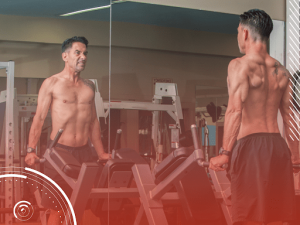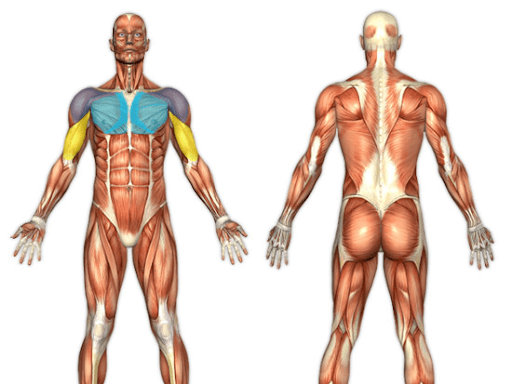3 Good Reasons to Eliminate Dips from your Chest Workout

Dips are a very effective exercise for building the lower chest and the triceps in chest workout. Frankly, there’s no denying it. It is for this reason that so many people are absolutely shocked when I tell them they should never do dips when they exercise.
These people usually ask me the question “Why not?”
They should begin by asking the question “Why?”
Why is it that so many people are determined to include dips as a regular part of their chest and triceps workouts? If the answer has to do with dips being the best exercise for building the lower chest, I would tell the person that they’re wrong, and I would also provide them with the same response if they told me dips are the best exercise for building the triceps.
So, with that out of the way, now I can address why people shouldn’t include dips in their workouts. There are three simple answers to this question, and once you’re aware of them, hopefully you will do the wise thing and remove dips from your training routines completely.

Dips are Very Dangerous for your Shoulders
When you train, it is important that you put yourself in the safest possible environment to cause the muscles being trained to grow into their strongest, most ideal form. In terms of the way they position the shoulder joint, dips are actually an incredibly dangerous exercise.
During the dip movement, the shoulders start to roll forward at the bottom of each repetition, which forces the shoulder joint out of its socket during each repetition. Certainly, the movement has strength-building benefits for the lower chest and the triceps, but in the process of generating this stress, the movement is absolutely wrecking the shoulder joint over and over again by keeping it in a very dangerous position.
This danger is compounded by the fact that people often perform dips after they’ve done other compound movements, and the muscle groups around the shoulder joint are already fatigued. This results in the joint being even more susceptible to injury than it would normally be by the time dips are executed during training.
Even under normal circumstances, when you’re doing dips, you’re performing a movement that’s very unsafe. That’s why I can’t encourage anyone to do them with a clear conscience. Even though you might get some positive results from dips, the side effects and the negative consequences simply aren’t worth it.

There is a Much Safer way to Build your Lower Chest
Now that I have dealt with the primary reason why dips shouldn’t be done, we can tackle the question of whether or not there is a better way to achieve the same muscle-building results as dips. Without reservation, I can tell you there are far better ways to build your lower chest.
I always talk about muscles being made in an arc formation, and that includes the chest muscles. So, whatever movement you do, you want it to be a movement you can control, and a movement that works your muscles within the arc formation they were designed in. Chest exercises are commonly thought of in terms of pushing and pressing movements, but the rotational motion of the shoulder is the primary force that results in the chest contractions that truly build the pectoral muscles.
When the shoulders go back and then push forward and down, it works a lot more of the lower pectorals. The most effective way to achieve this motion is with cables as opposed to dips. When you do a cable crossover, you can focus specifically on the lower pectorals. When the shoulders go back, it forces the entire pectoral region to get involved, and when you finish the rep by pushing low and down, it forces the lower pecs to do the majority of the work.
Remember to bring your shoulders back and then forward and down. The backward movement opens and stretches the pectorals, and then you should squeeze forward and contract downward to finish each repetition.

There are Much Better Ways to Train your Triceps
Training the triceps is fundamentally about straightening the arm by contracting the tricep muscles and extending the forearm out or down. No matter what method is being used to train the triceps, this way to build muscle in them is to extend the forearm and straighten the arm through a contraction.
When you keep this in mind and then analyze the dip, you see that the tricep isn’t placed in an optimal position to contract before the arm is extended. And since the chest assumes so much of the burden involved in stabilizing the body and pressing the weight, the benefit to the tricep comes primarily from flexing the tricep muscles at the top of the movement while it is holding up the bulk of the body’s weight.
The other problem with dips is that they make it impossible to mentally focus on the work being done by the triceps, because the triceps aren’t the primary driver of the movement, and you can’t really think about them until the movement is 75% complete. In practice, most people are so focused on simply manipulating their body positioning while they’re doing dips that they aren’t thinking at all about what the targeted muscles are doing.
If you want to train your triceps in a safe manner that allows you to give them your full attention, and in a fashion that allows you to maximize the focus on the triceps by contracting the muscles and keeping them squeezed throughout the movement, almost any form of tricep extension is more effective and efficient than dips. This includes cable tricep extensions, seated tricep extensions with the machine, tricep kickbacks, and any other tricep movement that enables the shoulder joint to remain in its socket while the triceps are being trained.
The key takeaway here is that dips are extremely bad for your shoulder joint. You may really love dips, you may have done them for a long time, and you may feel that you have extremely strong triceps because of them. You might even be able to do dips with the weight belt that hangs down and allows you to add a lot of extra weight, which is an impressive way to show off your strength to anyone who might be watching.
I understand these things are hard to give up if you love them. In the long run, they’re just not good for you, and there are better ways to get the results you want in both your chest and triceps. For more great fitness tips, feel free to check out the rest of the blog at RonWilliamsFitness.com, and also the Ron Williams channel on YouTube!






